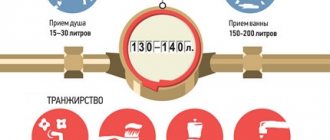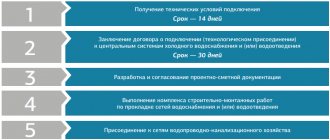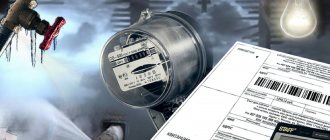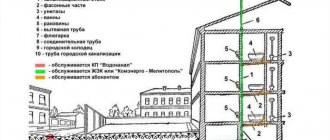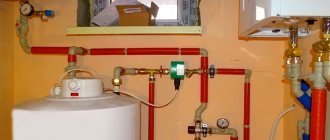Features of the service
The preparation of hot water for the needs of hot water supply occurs in centralized heating boiler houses, in the same place where the coolant of the heating system is heated.
Boiler rooms can be connected to a looped DHW system or be a dead-end type - designed for a group of houses or one house (for example, rooftop boiler rooms). The closer the consumer is to the source of hot water (boiler room), the better the quality of the service provided and the higher the water temperature. However, connecting to loop networks is preferable from the point of view of reliability and uninterrupted hot water supply.
The service includes:
- Boiler room maintenance. Unlike heating, hot water supply is provided all year round, while boiler houses switch to summer (minimum) operating mode.
- Trail maintenance.
- Carrying out scheduled repair work on networks.
Water heated in the boiler room for an open (unclosed) DHW system enters consumer apartments through supply water pipes, distributed through intra-house DHW networks.
The temperature of hot water for consumers is regulated by sanitary and legal standards and is +50…+65 °C. In reality, it often does not exceed +40 °C.
This is due to heat losses during the supply of coolant along routes (poor pipe insulation, gusts) or due to low temperature at the outlet of the boiler room. Boiler room operators adjust output parameters based on outside air temperature.
The service provider’s task is to provide apartments with a utility resource of appropriate quality.
Sometimes the heating network justifies poor-quality service provision by the deplorable state of the networks - routes built in the last century that require major repairs will not withstand temperature changes in winter if the parameters of the coolant at the exit from the boiler room are maintained at the standard level.
It turns out to be a vicious circle - many residents often do not pay for hot water due to its low temperature or refuse this service altogether, switching to heating water with electric boilers. And heating network enterprises cannot carry out repair work, because... the population's debt to pay does not provide them with an influx of cash.
In the video about the hot water service
Bottom line
Whether or not to pay for a hot water service if it turns out to be of insufficient quality is a purely personal matter.
It is important to understand that if you decide to take the path of non-payment, you do not need to simply create debts. It is necessary to collect the evidence base according to the following scheme: carry out commission measurements of water temperature, send the results to the company providing the services
Be sure to receive an official response explaining the reasons for the poor quality of the service. Having collected a package of evidence, you can go to court to assert your rights.
Cold water supply and hot water supply in the receipt - what is it?
The list of all utility services subject to mandatory payment by consumers is clearly stated in Article 154 of the Housing Code of the Russian Federation.
It also states that utility companies have the right to use abbreviations to designate a particular service. The law states that it is strictly prohibited to change names and their abbreviations, and they must comply with current recommendations. Considering the fact that there are a lot of abbreviations in the receipt, users often have the question of what cold water is.
The abbreviation HVS refers to cold water supply, and the abbreviation DHW refers to hot water supply. In addition, in payment documents the column may contain the term HVS DPU. It means that payment for consumed cold water occurs on the basis of a common house meter. If the receipt indicates the HVS KPU, this means that the consumer in the apartment has his own metering device, on the basis of which payments are made.
Tags
Sewage in Sewage in water supply and sanitation services sewerage service water supply and sanitation services Water supply water supply of hot water and Sewage in Sewage and sanitation service water disposal and sanitation Sewage service sanitation such sewerage in Sewage represented sewerage enters cold water and cold water.po cold water and in receipts in receipts in receipt in receipts In receipts nav receipts in receipts. In receipts owner receipts and in housing and communal services receipts
gwsresourcecleaningwaste disposalmaintenance
What is sewerage in utility bills in 2018
In utility bills, drainage is entered on a separate line. To determine the volume of water that goes down the drain, the readings of individual meters for hot and cold water or average monthly consumption standards are used. In the first case, this expense column is often called “Water disposal KPU”.
Since 2013, residents could find an additional line on the receipt “Water disposal ODN”. The abbreviation stands for “General Household Needs.” This is the amount of water that is spent on heating and cleaning entrances, basements, attics, watering house plants, “technical” losses, etc.
From 01/01/2017, the costs of drainage of “general” wastewater must be included in the costs of maintaining the property of the MDK. And their volume is calculated either using standards determined by regional authorities, or the amount of supplied resource according to common house (collective) sewerage meters, and if there are none, according to the water supply control unit.
That is, the management company (HOA, cooperative) does not have the right to write down “Water disposal for the maintenance of collective property” as a separate line. Such an overpayment must be contested through a claim or statement of claim in court.
Read here how to pay utility bills through the terminal.
How is it calculated
Calculation of utility fees in the presence of a utility bill is made using the formula:
Where cold water and hot water are the volume of cold and hot water consumed by apartment residents according to meters for the previous month.
Like other housing and communal services, sewerage is subject to federal or regional benefits:
- for invalids;
- veterans of WWII and other wars;
- heroes of Labor, heroes of Russia and the USSR;
- pensioners;
- large families (having 3 or more children);
- single mothers;
- low-income people and some other categories of citizens.
Benefits are issued at the social welfare department or at the management company. In this case, up to 50% of utility costs will be covered by the federal or regional treasury.
Current tariffs
Tariffs and standards are set by regional authorities. Thus, in the capital in 2021, the Decree of the Government of the Mountains is in force. Moscow No. 848 dated December 13, 2016. According to this act, the rate was indexed in July 2021; sewerage prices have increased by about 7% compared to the previous value.
An increase in fees for housing and communal services in the middle of the year occurred in all regions of the country:
Example. A metropolitan family used 8.3 m³ of cold and 4.1 m³ of hot water during the month according to the apartment meter. The total volume of water supply and, accordingly, wastewater disposal is 12.4 m³. The family must pay for sewerage an amount equal to 12.4 * 25.12 = 311.49 rubles.
If there is no counter
If there are no meters, water disposal is calculated according to the average monthly water consumption standards in force in the constituent entity of the Russian Federation.
The calculation includes the value of the standard, the number of registered (including temporary) residents and the tariff:
Standards are also set at the regional level and depend on the area of the room, the presence and number of baths, sinks or sinks, climate zone, condition of the centralized sewer system, etc.
For example:
Moreover, according to Resolution No. 354, if meters are not installed in the house, but there is a technical possibility for this, the standard is applied with an increasing factor. In 2021 it is 1.5.
Example. A Moscow family of 2 people bought a new building with a mortgage and did not have time to install individual meters in it. Accordingly, it pays for the use and disposal of water according to standards multiplied by the increasing coefficient and the number of registered ones. Thus, the cost of wastewater disposal will be 11.68 * 2 * 25.12 * 1.5 = 880.20 rubles.
They pay for sewerage, like other utilities and housing services, until the 10th of the next month. If you discover an error in the receipt, you need to submit a free-form recalculation application to the management organization (homeowners' association, cooperative). If the issue cannot be resolved amicably, the matter is resolved in the district court at the location of the property.
Here you can find a sample certificate for a subsidy for utility bills.
Registration of a subsidy
The concept of “subsidy” is integral to the Housing Code of the Russian Federation.
It was in this legal act that it was decided, in order to support various categories of citizens, to return part of the costs of paying for utility services in funds transferred to the recipient’s current account.
Read also: What is good about ecofiber filler?
In order to receive subsidies for utility services, several conditions must be met:
| No debt for housing and communal services | When applying to the relevant authorities to apply for a government subsidy, you must provide paid receipts for the previous month. If you have rent arrears, it is impossible to receive government support. To do this you will have to pay off your bills first. |
| Confirmation of income of all family members | When calculating the subsidy, the total family income of all family members living in the apartment is taken into account. If someone does not work or cannot officially confirm their income, it is impossible to receive a utility subsidy |
Thus, in order to apply to the social security authorities for citizens to receive subsidies, it is necessary to meet these two requirements for recipients of state support.
It is necessary to pay off debts and employ able-bodied family members.
Required documents
The list of required documents to receive a subsidy for utility services may vary not only in different regions of the Russian Federation, but also in nearby cities.
A complete list of documents is determined and approved by local governments, but the main package includes:
| Document | identification of the applicant (passport) |
| Statement | filled in when submitting documents according to the sample available to authorized employees |
| Documentation | evidence of ownership of the residential premises appearing in the application or the right to reside in it |
| Income certificates for each able-bodied family member | if one of the non-family members does not work, but is registered with the Employment Center, you must take a certificate confirming this |
| Certificate of family composition | and birth certificates for each child |
| Pension certificates | if there are elderly people in the family |
| Reference | about the size of the living space of an apartment or house |
| Statement of personal account | issued at the office of the management company or the office of the housing office and a house book |
This list looks impressive, but in fact it is not difficult to collect the package of documents necessary for a subsidy.
Certificates from the place of work take the longest to process.
If you apply for subsidies for utility services at the MFC of your city, then you can get almost all the certificates there (about family composition, statement of personal account, etc.), and they make requests to the Employment Center independently.
Thus, you can apply for subsidies in one visit to the MFC.
Who is entitled to benefits?
Every Russian family whose expenses for housing and communal services amount to 15-22% of the total family budget can apply for subsidies for utility bills.
However, there are certain categories of citizens, assigned at the federal and regional levels, who are entitled to benefits regardless of monthly rent expenses:
| Participants of the Great Patriotic War | they are entitled to a 50% discount on utility bills |
| Disabled people of all groups, as well as persons raising disabled children | the benefit provides for a reduction in utility bills by exactly half |
| Participants in the liquidation of the consequences of the Chernobyl disaster | I also have the right to receive a 50% discount on utility bills. In the event of the death of a Chernobyl survivor, widows have the right to receive benefits |
| Large families | According to Russian legislation, families raising three or more children are considered such. This category of citizens has the right to receive a discount on housing and communal services payments of at least 30% |
| Veterans of Labor | Citizens who have earned this distinction can count on a 50% reduction in the total cost of receipts. |
| Employees of budgetary institutions living in rural areas | benefits provided to this category of citizens are provided at the regional level and in some even reach 100% |
| Poor | Some regions have their own programs to support citizens in difficult financial situations. It is necessary to find out about existing programs and benefits from local government or social security authorities. |
| Single mothers, unemployed, pensioners | If there are no special support measures in your region, you can apply for a subsidy based on the ratio of utility costs to the family budget. If spending is 15-22%, you are entitled to government financial support |
A huge number of Russians can receive benefits or subsidies from the state.
To do this, you need to come to the relevant institutions and get competent advice on issues that interest you.
Ministry of Construction proposes to abolish mandatory social norms for electricity
Counter or standard
Amounts for individual consumption
(utilities used in the apartment) and for
general house needs
(GDN; for example, expenses for heating and lighting of the entrance) in the payment must be posted in different columns.
There are cases when the amount of payment for the use of utilities per person per person exceeded the amount of individual consumption in apartments.
This can happen when payments to ODN are calculated not according to meters, but according to standards (with an increasing factor due to the lack of a meter).
However, so far the practice is not in favor of residents.
You also need to remember that if more than 10% of a family’s income is spent on paying for housing and communal services in Moscow, you can receive government support in the form of subsidies.
In this case, you must contact the regional department of housing subsidies, presenting a certificate of income and a certificate of ownership. At the same time, there should be no excess living space: the established standards are 33 square meters. m per person, 42 sq. m - for two.
What to do if the bill is too high
If it turns out that the bill is inflated, you need to file a complaint with the management company. If she does not answer, you can file a complaint with the Housing Inspectorate (you can also write there immediately, without waiting for a response from the Criminal Code). You can also contact your regional tariff commission.
“The housing inspectorate can be asked to conduct an inspection, on the basis of which a recalculation will be made.
Payment for gas supply is calculated according to the tariff for each consumer living in the apartment.
Limit indices
The maximum index of changes in the size of citizens' payments for utility services is a universal tool for monitoring charges for hot and cold water supply, sewerage, heating, and gas. Changing the fee above the maximum index is unacceptable and should entail an immediate response from the executive authorities to eliminate this situation.
In the capital, the maximum index was approved by Order of the Mayor of Moscow dated June 30, 2014 No. 542-RM and from November 1 to December 31, 2014 it is 6.5 percent.
If you pay using a home metering device (DPU), the payment document indicates the abbreviations: “HVS DPU”, “DHW DPU” and “Water drain. DPU" - cold and hot water supply, water disposal according to the readings of the house water meter.
Calculation of charges for cold and hot water for apartments where no control units are installed is carried out in accordance with the resolution of the Moscow Government dated February 10, 2004 No. 77-PP.
From the volume of water consumption according to the readings of the house meter, the volume of consumption for all apartment devices, the volume of consumption for non-residential premises (if the house has, for example, shops, a hairdresser, etc.) are subtracted, and also general household expenses are deducted, which are determined according to the readings metering device installed at the place where water is collected for general household needs.
They are installed by resource supply organizations.
Previously, Gazeta.Ru wrote
that resource supply organizations often sabotage the installation of meters, since the standards bring them much more income.
If such a problem is discovered, you need to contact the Housing Inspectorate.
Pay attention to square meters and number of residents
You should check whether the area of the apartment is indicated correctly on the payment slip. Heating and payments for major repairs are calculated on a per square meter basis. Regional authorities allocate subsidies that compensate for part of the payments, but they operate only within the social norm (in Moscow this is 33 sq. m for one person, 42 sq. m for two), explains Valery Novikov. You will have to pay for housing surpluses.
Also, do not rush to register new residents.
How to detect deception?
How to check whether payments for consumed utility services are calculated correctly?
Of course, utility companies are trying in every possible way to write off their losses on consumers, so sometimes situations arise when the charge suddenly goes not according to the meter, but according to the standard, or the bills indicate larger amounts than the actual amount consumed.
To eliminate the situations that have arisen, the consumer is obliged to take the agreement with the utility company, the received payment, documents and the act of installing the metering device and go to the accounting department of such an enterprise, where they write an application for recalculation.
If this does not happen, you can write complaints to Rospotrebnadzor and law enforcement agencies, demanding that the perpetrators be punished and recalculated.
It is important to remember that recalculation can also be made by court decision if the consumer files a claim there.
The abbreviation HVS DPU means payment for consumed water, according to the house (apartment) meter.
You can find out what payment receipts for utility bills look like by watching the video:
28 Jun 2021 kasjanenko 629
What is hvs kpu and dpu in the receipt
08.04.
2018
The situation is as follows, in our apartment, before installing water meters, the calculation of consumption was calculated according to DPU DHW DPU 50m3 per month Cold water supply DPU 49m3s per month For those who do not know cold water supply DHW hot water supply DPU - house metering device KPU - apartment metering device In another apartment in another area, we have had water meters for a long time, and despite the fact that we very often use a washing machine, a dishwasher, we wash ourselves by filling a two-seater Jacuzzi, we wash our hands in the shower, we wash the water, we drink water, and we use the toilet at full capacity, the total consumption of hot water + hot water is approximately 5-10 m3. Okay, we think since we don’t have meters in this apartment, then the EIRC can mock as it wants, taking revenge on conscientious payers for malicious non-weavers. We didn’t wait long and experience injustice, we installed and registered water meters in the Otradnitsa apartment as required, well, we think now everything will be fair, now we’ll pay according to our consumption, now we’ll be happy.
What does the abbreviation HVS DPU mean?
The nuance is that if accounting is kept by an enterprise, then it will blame all kinds of losses in water and its temperature (for example, breakthroughs, leaks) on consumers, and they will pay for it. If a house has a communal meter installed, then residents will pay for the water and heat supplied to the house.
Cold water supply (CWS)
- The permissible duration of interruption in cold water supply is 8 hours (total) for 1 month
- The permissible duration of a cold water supply interruption is 4 hours at a time, in case of an accident in centralized engineering support networks
- The composition of water must necessarily comply with sanitary standards SNiP 2.04.02-84
- Pressure in the cold water supply system in apartment buildings and residential buildings - from 0.03 MPa (0.3 kgf/sq. cm) to 0.6 MPa (6 kgf/sq. cm)
- The pressure in the cold water supply system at the water taps is not less than 0.1 MPa (1 kgf/sq. cm)
Hvs on the receipt what is it
Water supply and sewerage are two completely different utilities. Water supply means that cold water goes through cleaning and disinfection before entering the apartment, and hot water is heated to a certain temperature.
Drainage is the removal of any waste water from the apartment. The service involves the primary purification of water and its direction to the sewer system. This is a complex technical process consisting of several stages.
After the water is drained, it is delivered to treatment facilities, where it undergoes multi-stage purification and is disposed of.
Why do you have to pay for it?
The authorities planned to divide utility bills for water supply in order to reduce costs, but it turned out that now people pay twice as much as before. Payment for consumed resources is determined by the “Rules for the provision of services (utilities) to users and owners of premises of residential and apartment buildings.”
The rules establish that even if you do not consume a particular resource, for example, gas, it will apply to dwellings that do not have an individual meter. In simple words, you will pay both for yourself and for people who do not have a meter.
You can write a complaint, and if a miracle happens, representatives of utility services will reflect on their “Rules”.
Although not all water is sent to the sewer (used for drinking, cooking and watering plants), this is how it is accounted for.
It is clear that the size of this utility payment is somewhat larger than for the supply of water supply, however, it is worth remembering that the diverted water is then sent directly to treatment facilities, which clean it.
Some citizens cannot understand why they pay for sewerage if they already suffer the costs of paying for cold and hot water. However, there is a legislative norm that clearly states the reason for this utility payment and how the payment is calculated. Water supply and sanitation - what is it and what is the difference in the meaning of these concepts?
Payments to housing and communal services for the supply of water and for its disposal are completely different services. This should never be forgotten. You also need to pay for sewerage regardless of whether you have metering equipment or not.
This is interesting: Calculator for calculating the length of the contour of a water heated floor - with the necessary explanations
Opinions of the arbitration and appeal courts
The first court to consider the case was the Arbitration Court of the Moscow Region. RSO insisted that the management organization must pay for the supplied resource according to meter readings. In response, the management company provided a counter-calculation of the debt, based on the application of calculation of payment for thermal energy used to heat water, in accordance with Decree of the Government of the Russian Federation dated May 6, 2011 No. 354. The figures that the RSO demanded were greater than those calculated by the UO.
The Arbitration Court of the Moscow Region decided to partially satisfy the claims of the RSO and recover from the management organization most of the amount demanded by the plaintiff as debt, penalties and payment of state fees for legal expenses. He explained that the heat supply organization calculates the fee incorrectly, so the management company must return the amount that will be obtained if the calculations are carried out correctly.
Although the requirements of the RSO were satisfied, it turned out that the court sided with the management organization, because it did not refuse to pay at all, but wanted to receive a correct calculation.
The heat supply organization was dissatisfied with this decision and filed an appeal with the Tenth Arbitration Court of Appeal, which overturned the decision of the Arbitration Court of the Moscow Region.
The Court of Appeal was guided by Art. 157 of the Housing Code of the Russian Federation and Federal Law No. 190-FZ of July 27, 2010, and proceeded from the need to determine the volume of thermal energy supplied for heating water during the disputed period according to the readings of a working meter previously installed for the subscriber, and not on the basis of the heating standard.
This time the management organization did not agree with the decision. She was confident that she was right and decided to appeal the case to the Arbitration Court of the Moscow District. But this court came to the defense of RSO and refused to satisfy the demands of the management organization, leaving the decision of the previous court in force.
The UO decided not to give up and filed a cassation appeal with the Supreme Court of the Russian Federation. In it, the UO referred to the incorrect application of the law and asked to cancel the said decisions of the courts of appeal and the district, leaving in force the decision of the Arbitration Court of the Moscow Region.
Representatives of the resource supplying organization objected to the satisfaction of the complaint, citing the legality and validity of the appealed decisions.
That Kpu In Receipt What Is It 2021
Consumption standards for ODN can be found on the official website of the local administration or your management company. Exceeding these standards is unacceptable by law, but the exception is the presence of an agreement signed by the general meeting of residents.
- lighting of the local area and entrance;
- functioning of the elevator and water supply pumps in the house;
- heating of technical premises and entrance;
- lighting of the elevator, attic and basement;
- cleaning of premises and local area;
- operation of intercom and video surveillance (if available);
- preparing the house for the heating season;
- cleaning communications.
Residents without meters will pay in full, since tariffs from January 1 will be calculated according to the increased increasing coefficient for all residents of the country. Housing and communal services tariffs will also change for those Russians who live in premises where a communal heat meter is not installed. The growth of electricity tariffs, unlike gas, will be slower for the population than previously expected.
The cold water component is determined:
There are many lines in this document, and each of them contains a service, the meaning of which cannot be quickly understood. Even a child knows that you need to pay for electricity, gas and heating. But what is drainage in utility bills?
If water is taken from a water supply source by some third-party organization that has the right to do so, or is processed to turn it into drinking water, then the tariff for cold water can be set based on the material costs of this organization per 1 m3 of water.
In order to understand this abbreviation, residents and owners of apartments in multi-storey buildings must have a complete understanding of all utility bills that are calculated for the services provided.
Tereshkova, 12 and 8 weather control systems have not yet been installed. However, energy-saving measures that have already been carried out (replacing windows in entrances and basements with plastic ones, insulating basements, partially replacing risers, etc.) have produced a good saving effect. Payments have decreased compared to last year.
It is not permissible to change the names of these services, although some regional housing and communal services arbitrarily enter into their own payment receipts such lines as “DHW heating”, “DHW replenishment” or “DHW and hot water discharge”. It is not at all necessary for the consumer to know how much it costs to heat water; what is important to him is the last price that is presented for payment.
Some of them continue to operate, setting, for example, tariffs and requirements for the quality of water supplied to apartments and then discharged into natural reservoirs.
It is unacceptable to change the names of these services, although some regional housing and communal services arbitrarily enter into their payment receipts such lines as “DHW heating”, “DHW replenishment” or “DHW and hot water drainage”. It is not at all necessary for the consumer to know how much it costs to heat water; what is important to him is the final amount that is presented for payment.
Drainage KPU - water disposal of some KPU. I’ve never even heard about collective metering devices for wastewater disposal, let alone apartment ones. And for some reason, in the “quantity” column a figure is shown equal to the sum from the “quantity” column for cold water supply and hot water supply. Those. As much as it came into the apartment, so much went out. What about cooking, drinking, washing floors, etc., watering flowers? Many people still associate the increase in heat supply fees with the increase in tariffs. But that's not true. Charges for the service in the new heating season were made according to tariffs approved in the summer. And the amounts in payments increase when, due to cold weather, the temperature of the coolant increases and, accordingly, the volume of thermal energy consumption, which is recorded by collective metering devices.
Submit your meter readings to your supplier or management company every month. You can calculate for yourself how much sewerage costs and compare the amount received with the amount of payment indicated on the receipt.
If there is none, the management company makes calculations according to current standards and issues an invoice to the residents. In different regions, local governments set their own tariffs for wastewater disposal.
Regulatory regulation
What is drainage in utility bills is explained by Federal Law No. 416 of December 7, 2011. It replaced numerous disparate federal and local laws
. Some of them continue to operate, setting, for example, tariffs and requirements for the quality of water supplied to apartments and then discharged into natural reservoirs.
Federal Law No. 416 describes:
- powers of central, regional and local authorities in the field of wastewater disposal;
- methods for ensuring and checking water quality, its compliance with environmental standards;
- drainage procedure;
- tariff regulation rules, etc.
Sewage as one of the public services is also affected by the Housing Code of the Russian Federation in Section VII. The Code establishes, in particular, the obligation of citizens - residents and owners of premises - to pay for the receipt and disposal of used resources
. It describes the calculation procedure and sanctions for the occurrence of debt for housing and communal services.
The latest changes to the Code, dated July 2021, relate to resources spent on general household needs. Previously, there was a contradictory practice, according to which in some regions of the Russian Federation the courts allowed the Criminal Code to collect fees for sewage disposal
. The Housing Code and other acts adopted quite recently finally explain what the water disposal system is in utility bills in 2020, and why there is no single charge.
Decree of the Government of Russia No. 354 of 05/06/2011 supplements Law No. 416 and the Housing Code of the Russian Federation with the rules for the provision of housing and communal services and the procedure for calculating fees for them. It provides formulas by which any citizen can check whether there are any errors in the housing and communal services receipt.
Resolution No. 306 of May 23, 2006 determines the methods and procedure for setting standards for cold and hot water supply (and, accordingly, sewerage) if the house is not equipped with apartment-by-apartment metering devices. Their values are set by regional authorities and published publicly on the websites of departments or management companies.
KPU on the receipt
The concept of KPU drainage can be encountered by apartment owners in many buildings. It means drainage, that is, draining all wastewater. In this case, the total amount of hot and cold water spent for general house needs goes down the drain. However, this formulation is largely incorrect, which misleads consumers.
- There are no metering devices for water discharged into the sewer system that could separately calculate how much is spent on general household needs. Therefore, this column can indicate almost any values that will be convenient for the service provider, since the end consumer will not be able to verify or refute them;
- laws do not contain this wording. What payments the management company can demand from people is prescribed by law. Therefore, all correct columns contain the entry “common house” or “common.” metering devices. You can actually check them and compare the charged fee with the real values.
Water disposal kpu in the receipt what is it
In the absence of metering units, the costs of consumed cold and hot water, and, consequently, the amount of water disposal, are determined according to standards approved by local authorities in each region of the Russian Federation and in cities of federal significance - Moscow and St. Petersburg.
- There are no metering devices for water discharged into the sewer system that could separately calculate how much is spent on general household needs. Therefore, this column can indicate almost any values that will be convenient for the service provider, since the end consumer will not be able to verify or refute them;
- laws do not contain this wording. What payments the management company can demand from people is prescribed by law. Therefore, all correct columns contain the entry “common house” or “common.” metering devices. You can actually check them and compare the charged fee with the real values.
How to refuse KPU maintenance
By the way, the Consumer Protection Society characterizes the imposed
and all sanctions will actually begin from this year, because the absence of a certificate of timely verification is equated to the absence of a meter as such, accordingly the Criminal Code will begin to charge at the current tariff, this time, but here the Jewish nature of some residents is very often included: and There are two people registered with me, but four people live, it’s more profitable for me without meters, and this case is now provided for: starting this year, increasing coefficients are being introduced to calculate the cost of water in apartments that are not equipped with water meters https://www.rg.ru/201. /schetchik.html.
When checking water meters, unscrupulous organizations often allow pensioners or simply inattentive people to sign an Agreement for the maintenance of water meters (MOT for meter maintenance). In 2021 they charge about 50 rubles a month for this, 600 rubles a year, 3000 rubles for 5 years.
How to deal with this scam?
Additionally, I inform you that during the conclusion of this agreement my civil rights were violated: i.e. I did not know that I was signing such an agreement; the citizen who introduced himself as an employee of STEK LLC did not let me read the agreement and did not explain the procedure and essence of this agreement.
Tariff calculation in an apartment building
Payment for sewerage is made taking into account the indicators of water used. The volume of water spent is taken into account.
The funds from this payment are used by the utility to arrange the transportation of the waste liquid to special treatment facilities.
This indicator is calculated very simply: hot water supply (hot water supply + hot water supply) is multiplied by the established tariff. This formula is provided for by law, so even if the resulting amount is large, you cannot avoid paying for drainage services.
Features of drainage in the house:
- In an apartment building, it is customary to use common building equipment for accounting. It is based on the indicators of such a device that the drainage fee is calculated.
- If there is no communal equipment, the utility company will be billed for this service.
- Some owners install their own meter in the apartment. Before installing such a device, you must submit an application. Only after obtaining permission is the device mounted and sealed.
In order not to pay for extra cubic meters, it is recommended to pay attention to information about the amount of hot and cold water used. If the sum of these values in the payment slip is less than the figure indicated in the “sewage” column, you should file a complaint with the court
Payment for sewerage in an apartment building tariff and calculation
The tariff for sewerage is set based on various parameters. Please note that there is no single tariff for Russia, and each region has its own special values. When determining the size of the tariff for payment for sewerage, the following parameters are taken into account:
- climatic and weather conditions of the region;
- current state of sewer networks;
- assessment of the performance of water supply networks;
- distance of pumping water and waste;
- the quality of pumping stations, as well as their remoteness;
- the number of users consuming this service (in particular, those who have a separate meter);
- payment for the services of emergency crews and specialists ensuring the maintenance of networks in acceptable condition. They pay separately for the services that the water supply system requires;
- payment for work of water utility employees.
Depending on the above parameters, there are always significant differences in the size of the tariff scale. So, for example, for residents of Surgut the figure is 25.44 rubles per cubic meter. m, in Rostov-on-Don this value is 24.26 rubles per cubic meter. m, and in Krasnoyarsk the tariff differs the most - 9.42 rubles per cubic meter. m. If the value has increased, the consumer will be notified about this in advance.
To calculate drainage, 3 methods are used:
- Each apartment (private house) has an individual metering device, which is used to determine water consumption.
- Water consumption is determined based on the indicators of common house meters.
- Based on general standards.
Each method has its own characteristics, however, for consumers, the most profitable is the one in which a personal meter is installed in apartments.
Maintenance of KPU water flow meters maintenance
Thank you for your answer, but in paragraph 4.1.16 of the contract I mentioned, it is clearly written that if the management company concludes an agreement for the repair and maintenance of water meters with a third-party organization, payment for these services will be included in a single payment. The question arises, how will it turn on? In fact, the provision of these services?
Dear Lydia! Services for KPU maintenance, repair and verification of meters are regulated by a separate agreement, which you can conclude with any specialized organization, or you can choose not to do this and pay for repairs upon the fact of the service provided. No one is going to include in your single payment document either the fee for the maintenance of the control unit, or the fee for repairs and verification. The website clearly reflects changes in the provision of these services. In a word, you do not enter into an agreement with the management company for maintenance, repairs and verification and do not pay for it, and we do not provide this service to you! You will build all relationships with special organizations regarding meter maintenance (repair, verification) yourself. In any case, the management company has the right to take control readings, inspect the integrity of the seals and require you to carry out the next verification (the deadlines are indicated in the passport for the meters), no additional fee is charged for this.
Rules for reducing rent
In this matter, the following points need to be taken into account:
- You can reduce the fee when providing low-quality services.
- In the absence of necessary maintenance of metering devices.
- With illegally inflated fees.
- In situations where the fee exceeds 20 percent of total income.
Only in these situations can you really count on a reduction in utility bills. Everything happens exclusively at the written request of the person, since the reduction is exclusively of a declarative nature.
Thus, the receipt includes many alphabetic symbols and codes: IPU, IND, ZPU, ADS, AZU, AKHN, BULA, VIC, ASPZ, AHR, IKU, OID, SOID, GUP, etc. Essentially, this is one and the same same name for different utilities
. For example, OID and SOID apply to the general property of MKD, IPU and IND - mean payment for metering devices, ZPU and ADS - also to metering devices in terms of sealing.
In receipts for payment of housing and communal services there is a column “sewage”. This is a separate service for which you need to pay in the same way as for the supply of water, electricity, and heating. In this article we will explain what it is - drainage on a receipt, what is included in the service and what affects the payment amount.
Otop en pl transcript
The more people there are, the more expensive it will be, for example, for water (if meters are not installed). If one of those registered in the apartment does not live in it for a long time, then a recalculation can be achieved. You just need to prove your absence - for example, bring a certificate from the management company from your real place of residence. The same applies to summer residence at the dacha and long business trips: if the appropriate documents are available, the management company is obliged to recalculate. New line - major repairs
Calculating how much you should pay for a new service is simple. In Moscow, the monthly fee is 15 rubles. per sq. m. The new line appeared in the capital in July and has already caused a wave
discontent.
Previously, Gazeta.Ru wrote
that Muscovites want to conclude an agreement with the Overhaul Fund on their own terms and demand that a number of significant points be taken into account in the agreement.
Such systems do not protect the apartment itself, but entrances, stairs, attics, etc.
AUR
AUR is also a specific line of expenses in payments. This includes a set of payments aimed at ensuring the work of the administrative and management apparatus, for example, a management company.
OPU
OPU includes the volume and types of costs for the collection, repair and installation of various metering devices, such as water or gas meters.
ELDT
This is the “daily consumption on the electric meter”. As a rule, such consumption is not indicated in all regions.
The night consumption of the EBDT can also be indicated in a separate line.
VDGO
The interpretation of this concept includes the provision and maintenance of gas equipment. VDGO includes stoves, gas boilers, and water heaters.
There are also services that citizens do not actually use: for example, paying for an antenna and radio point. They can be waived individually by contacting the Criminal Code with a request to exclude these items from the general account.
Eastern District News Internet portal of the Eastern Administrative District of Moscow
In addition, the clause stating that the maintenance fee will be included in the monthly EAP is often printed in the smallest print. And since the amount is 50-100 rubles.
- in general, not very large, then the resident only notices after a few months that the total amount of rent has increased slightly, and a new line has appeared in the EPD. Why is maintenance included in the EPD? In the press service of public service centers.
Moscow explained that a line with a fee for the maintenance of apartment metering devices (TO KPU) is entered into the EPD after the resident signs the appropriate agreement with the company servicing the water meters.

